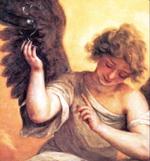Catholic Activity: Martinmas Traditions
St. Martin of Tours is another large harvest day, particularly tied in with the harvest of grapes in France. His feast is also known as "Martinmas." Recipes included is haggis and almond horseshoe cakes.
DIRECTIONS
Now that we have eaten fish for St. Peter and mutton for St. Bartholomew and pig for St. Michael, it might be well to finish with the other remaining fall harvest feasts. Three more days were set aside in November for completing the winter work of preparing provisions of meat and drink. Each day was placed under the care and patronage of a very masculine and saintly gentleman.
St. Martin's Day on November 11 was celebrated from north to south and back again. Few saints have been so popular. He was patron of the world. From the ice-bound coves of north Scotland to the vine-covered slopes of south Sicily, St. Martin was beloved by all.
First he was patron of vine-growers, vintners and tavern-keepers, so his day was the day of wine harvest. If you have ever made wine and watched the beautiful purple juice turn to milky ferment, you wonder if it would not have been wiser to just make grape juice. Slowly the rising bubbles and the falling dregs clarify the keg. But you must wait until St. Martin's day to taste your new wine. St. Martin had shared his cloak with a drunkard and thus recognized Christ in one of "these least" ones. In remembrance of his charity, share your new wine with your neighbors and have a holiday; but remember this and every day is the day to "taste" the new wine, not to "guzzle" it.
Since St. Martin was generous to the beggar, this is also the feast day of beggars. For this reason, the children of Estonia beg goodies from door to door. Our American children would delight in the apples, cookies and nuts which the Estonian housewife gives her little beggars, but how many of our "finicky" young fry would rejoice in receiving a turnip? Yet this is the most-prized donation.
When we read this story of a far-away land to our family, they were strangely silent. We who live in a climate blessed with warm days in the mid of winter have to stop to even imagine whole months of zero weather. Our roads are open and each one leads to a store or market where garden fresh vegetables seem to grow on the counters. Our cellars have a freezer—a miracle box, where fresh fruits and vegetables are frozen and yet not blackened. If turnips were your only winter vegetable, and a scarce one at that, you would be grateful to have a turnip in your beggar's sack. We noticed that Ann ate her "hated" sweet potatoes without a word on the following day. Mary cleaned her plate of customary scraps. We all said our thanksgiving after meals with more devotion.
St. Martin's Day was, you remember, the feast after the great winter killing. All the special products of the slaughter were used as feast day specials. The large animals like oxen and cows were not killed until cold weather, so Martinmas was a great meat-eating time. There was once a legend that St. Martin was martyred by being cut up and eaten in the form of an ox. As a result, whole oxen were roasted for a community feast after every one had helped with the butchering. Cooperation and neighborliness was a necessity. As the old cantankerous farmer declared, "I can't afford to quarrel with my neighbors, I need them too often." One ox was often killed for St. Martin and the meat given to his poor.
Pudding was the first dish which gathered the by-products of butchering and made of them a gourmet's delight.
It fell about the Martinmas time, And a gay time it was then O That our gudewife had puddings to make, And she boiled them in the pan O.There were blood puddings and suet puddings and black puddings and white puddings. All sorts of meal was used as the base, from the simple oatmeal used in Scotland to a meal called Viljandikama in Estonia. This latter included as many as fifteen kinds of grain and dried vegetables ground together. I have a suspicion that the people of Viljandi were just showing off their fine harvests by putting samples of everything in the pudding.
A second special for Martinmas was Black Soup or Svartsoppa. Certain localities, like south Sweden and parts of Denmark, always served goose on this feast day, but the scraps and rejects were first made into a wonderful soup. The wings, neck, liver and blood of the goose were cooked into a broth rich in vitamins and minerals. A little wine and brandy were added for zest and tang.
The ultimate in making much of nothing was achieved by centuries of Scotch cooks when they created their famous Haggis. In fact, this dish was prized so highly that it has been called the national dish of Scotland. We have never made a Haggis in our house, but come next Martinmas we will be tempted to try it. The word Haggis comes from an old derivative meaning to hack or chop. Don't "you look down wi' sneerin' scornfu' view on sic a dinner."
By this time of the year you may be enjoying "St. Martin's summer," now known as Indian summer; but if the snowflakes are falling, the children will come running. "Remember, mother, you are expecting a guest for dinner. St. Martin comes in the snow, you know, on his snow white horse just when you least expect him. Bake some almond horseshoe cakes for his horse and he will bless you for it. Let us help. We know how."
Activity Source: Cooking for Christ by Florence Berger, National Catholic Rural Life Conference, 4625 Beaver Avenue, Des Moines, IA 50310, 1949, 1999






